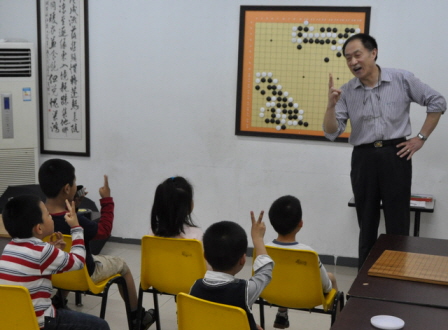The Traveling Go Board: Shanghai 2

The Shanghai sky is falling in great wet sheets as our taxi careens down the freeway into town. None of the seatbelts work, not even the driver's, who's slaloming through an obstacle course of Saturday morning traffic puttering along at 70 miles an hour. A few white-knuckled minutes later we stagger out of the cab and — after grabbing a quick steaming-hot pork dumpling at a street vendor — meet Du Yufeng 3P, who takes us to the Blue Elephant Go School, just around the corner from the famed Fudan University. Founded in 2002, the Blue Elephant is by far the biggest go school in Shanghai — of some 15 — with 400 students. Founder Lao Jian Qun meets us as we exit the elevator and proudly gives us the grand tour of the school's nine classrooms. In one room several 4-year-old beginners wave their tiny hands frantically in the air for the chance to solve the go problem projected on the wall. In another, teacher Li Jun Liang deftly draws the crowd of 8-year-old kyu players into today's lesson on sente with humor and a steely glint in his eyes. "This move kills two birds with one stone!" they all shout together, raising two fingers gleefully. And in a third classroom, half a dozen dan players break away from their lesson to beg us to play. E-Journal photographer John Pinkerton and I oblige as the rain draws a grey curtain over the Shanghai skyline outside. John manages to beat Lin Lin, his 9-year-old 1-dan opponent but my budding 4-dan, 12-year-old Xu Wen, proves to be too tough and I soon resign and thank him for the game. Classes meet daily — though the biggest concentration is on the weekend — taught by a 12-member faculty that is half professionals and half strong amateurs. "Most have extensive teaching experience," Lao tells me, "some as much as 20 years." As at the school we went to Friday night, the emphasis is "not just on the mechanics of the game," Lao says, "but on the traditions and culture of go," as well on the other three classical arts: drawing, music and calligraphy. One floor down is a separate but related school that offers classes in dance and tae kwon do, while next door is an art school with one whole classroom devoted to calligraphy. "We believe that these arts help children's focus in their other studies as well as in life," adds Lao. Teacher Li explains that counting liberties is a way "to slip a little math into the go lesson." As Lao sees us out, I ask him what inspired him to found the school. "Because go is so deep," he says, "and has such huge possibilities." Just like children.
- Chris Garlock; photos by John Pinkerton
- American Go E-journal
New update
